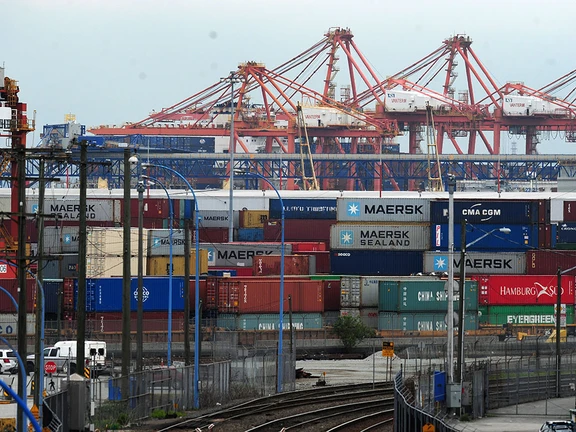A port in a storm
Trucking after the BC Ports strike
The BC port is port in a storm of conflict from Political, Unions, Businesses and Commerce factions, all working their agendas. But why is this such an important conflict to solve?
The BC port system is about the same size as the next five largest Canadian ports combined, enabling trade of approximately $305 billion in goods with port activities sustaining 115,300 jobs, $7 billion in wages, and $11.9 billion in GDP across Canada. One can see why competing agendas make this topic complex.
Canada Press reports other groups, including the Greater Vancouver Board of Trade, the B.C. Council of Forest Industries, the B.C. Chamber of Commerce and the Mining Association of B.C., said at an event in Vancouver that they are continuing to call for federal back-to-work legislation to end the strike involving 7,400 dock workers at more than 30 ports, including Canada’s busiest, the Port of Vancouver.
Board of Trade president and CEO Bridgitte Anderson said, “Every single hour and every single day that this labour dispute goes on, we are putting our international reputation at risk, we are putting jobs at risk, and it’s also hurting our economy.” Anderson said an estimated $8.9 billion in trade has been disrupted since the strike began, and 63,000 shipping containers are “waiting on the water to be unloaded” at B.C. ports. That number could balloon to 245,000 by the end of July if the strike isn’t resolved by then, she said.
B.C. Premier David Eby said, “This isn’t just the Port of Vancouver, it’s the port of Saskatchewan, it’s the port of Alberta and it’s the port of Manitoba,” Eby said. “So, it’s critically important infrastructure for Canadians, for people who go to work in industries where those goods are exported globally. “It has a profoundly damaging impact across the country on workers who are also trying to feed their families right now.” But Eby also said the union’s concerns about inflation and rising costs of living are real, and there was a need for striking port workers to “be treated fairly.”
Michael Goehring, President and CEO of the Mining Association of B.C. said some customers from foreign markets have been asking about the port strike and when it will end. Goehring said some member mines have diverted shipments to other ports, while others resort to stockpiling products on-site or in railcars. “There are physical and financial limits to how long mines can continue to do this,” he said. “. If the strike continues for much longer, some of our members will have to start planning for shutdowns and temporary layoffs.”
A British Columbia group launched a real-time “Port Shutdown Calculator” to show what they say is the cumulative cost of the strike. Fiona Famulak, President and CEO of the B.C. Chamber of Commerce said Canadian consumers would begin feeling the wider impact of the shutdown “in a matter of days” if they did not already.
Notable: The Port of Vancouver plays an important role in the region’s prosperity, handling $1 in $3 of Canada’s trade in goods beyond North America through imports of consumer goods like clothing, food and electronics and exports such as wheat, B.C. Forest products, and craft beer.
When port container truck operations are efficient, fair and safe, it provides opportunities and benefits for everyone in the supply chain from ocean carriers to importers and exporters; terminal operators to drivers and trucking companies; and retailers and consumers. When the port is not operational the backlogs begin to worry those who move goods. What will the backlog look like? How will it effect current operations when the freight dam is released? The British Columbia Maritime Employers Association (BCMEA) said it has learned of layoffs in “related industries”, as well as cargo diversions and economic impacts. The association estimates $4.6 billion in truck cargo has potentially been disrupted so far.
After Strike Recovery?
While the production ramp-down at the ports was seen immediately, the congestion because the strike will have a lasting effect on ports. The ramping back up takes weeks before efficiencies will be regained. By combining the wait time of vessels getting into port and unloaded, and containers loaded onto the rails, combined delays can extend from a month to at least two months for a U.S. arrival.
The ports strike has already damaged the U.S. supply chain. In data released, the American Association of Railroads reported year-over-year intermodal Canadian rail was down almost 50% last week as a result of the strike. The top sectors impacted included forest products such as lumber and wood products, oil and petroleum products, non-metallic minerals such as crushed stone, sand, stone, clay, and glass products, and chemicals. Products that go into paints, coatings as well as acids from Asia, were the most impacted, according to the National Association of Chemical Distributors.
Dan Kelly, CEO of the Canadian Federation of Independent Business, said the past two weeks were “painful and stress for small businesses,” which have fewer resources and less leverage to lean on.
Those in manufacturing, wholesale and retail were most affected, with two-thirds or more feeling the impact, according to its survey.
“Now is the time to get the economy rolling, clear the backlog and get shipments moving as soon and as quickly as possible. Even if port activities resume today, it will take months before the supply chain backlog created by the strike is fully addressed,” Kelly said in a statement.
Example: When the strike is finally settled, Paul Edgerton, founder of PureLite Glass in Ajax, Ont., said 60 per cent of the materials he uses to make windows for homes and commercial buildings come from Asia via the West Coast.
“That’s already starting to run out,” he said. “And the recovery period is going to be at least four weeks.”





















